Want a Range Rover but can’t spare $300,000? Perhaps we can interest you in this – the new Hyundai Palisade.

It looks a bit like a Range Rover – at least on the outside – with huge proportions and a boxy profile.
It somewhat feels like a Range Rover on the inside, too. The cabin is loaded with Nappa leather and suede, while space is hardly an issue.
Does the Palisade perform like a Range Rover? Not quite, but the gap in capability is smaller than you might expect.
So, is the new Palisade really a Korean Range Rover? And if it is, what does that mean for similarly priced mainstream seven-seaters like the Toyota Kluger, Kia Sorento, and Mazda CX-90? Keep reading for all the answers.
How much does the Hyundai Palisade cost?
Priced from $89,900 plus on-roads, the all-new Palisade Calligraphy Hybrid is more expensive than the outgoing Palisade, which topped out at $81,719 plus on-roads for the diesel-powered Calligraphy Black Ink AWD.

| Model | Price before on-road costs |
|---|---|
| 2026 Hyundai Palisade Calligraphy Hybrid AWD | $89,900 |
Not only is the new Palisade dearer than its predecessor, it’s also pricier than direct rivals including the Mazda CX-90 G50e Azami ($86,070 before on-road costs), Toyota Kluger Grande ($85,135 before on-roads), and Kia Sorento PHEV GT-Line ($84,660 before on-roads).
However, the Palisade Calligraphy remains significantly cheaper than German equivalents such as the Mercedes-Benz GLS, BMW X7, and Audi Q7. And, circling back to earlier comparisons, it costs roughly one quarter as much as a base seven-seat Range Rover ($321,000 plus on-roads).
Those on a tighter budget might want to consider waiting until next year when Hyundai has promised to introduce several cheaper variants of the new Palisade, including non-hybrid and front-wheel drive versions.
To see how the Hyundai Palisade lines up against the competition, check out our comparison tool.
What is the Hyundai Palisade like on the inside?
Premium, plush and practical are three words that immediately come to mind.
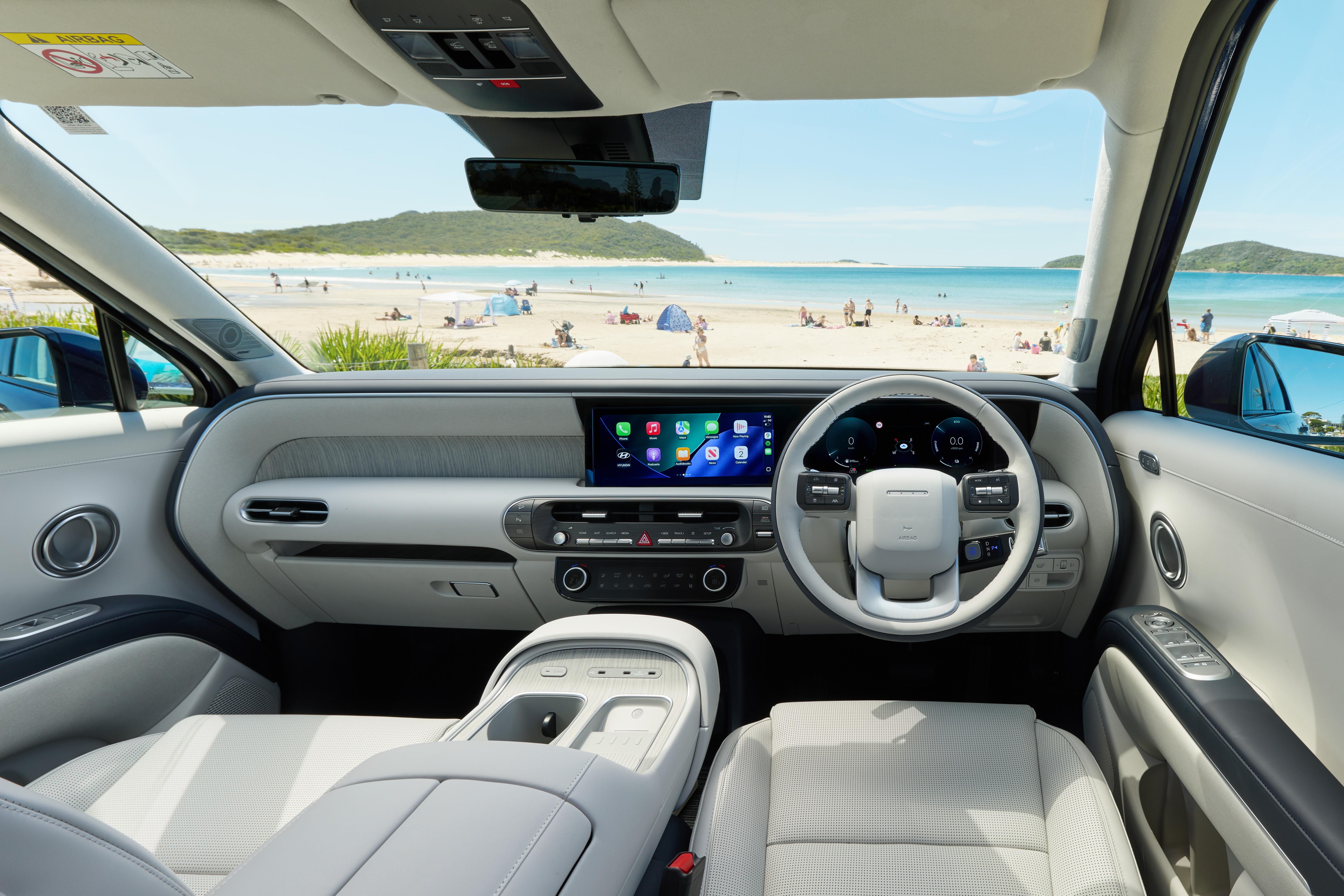
Upon opening the driver’s door you’re greeted by a generous front row that appears more roomy than most. In part that can be attributed to a floating centre console that unlocks space between the seats, but it’s mostly down to the fact that the Palisade is just a really big car.
It’s a really comfortable car, too, especially as a seven-seater. In this configuration, extendable leg rests can be found in rows one and two, while all three rows of seating feature electric adjustment and heating (outboard only) – an impressive set of specs for a $90k SUV.
But wait, there’s more. Both front seats offer three-stage cooling and lumbar support, too. Additionally, the driver receives extra special treatment in the form of a comprehensive massage feature and electric bolster adjustment.
Indeed, the Palisade’s wow factor goes far beyond its luxurious seating arrangement. Because once seated, you soon find that the position of the steering wheel can also be adjusted at the touch of a button… and what a lovely steering wheel it is. Trimmed in two-tone Nappa leather as tested, the wheel could easily have been pinched from Genesis or Bentley, which is high praise for the not-so-humble Palisade.
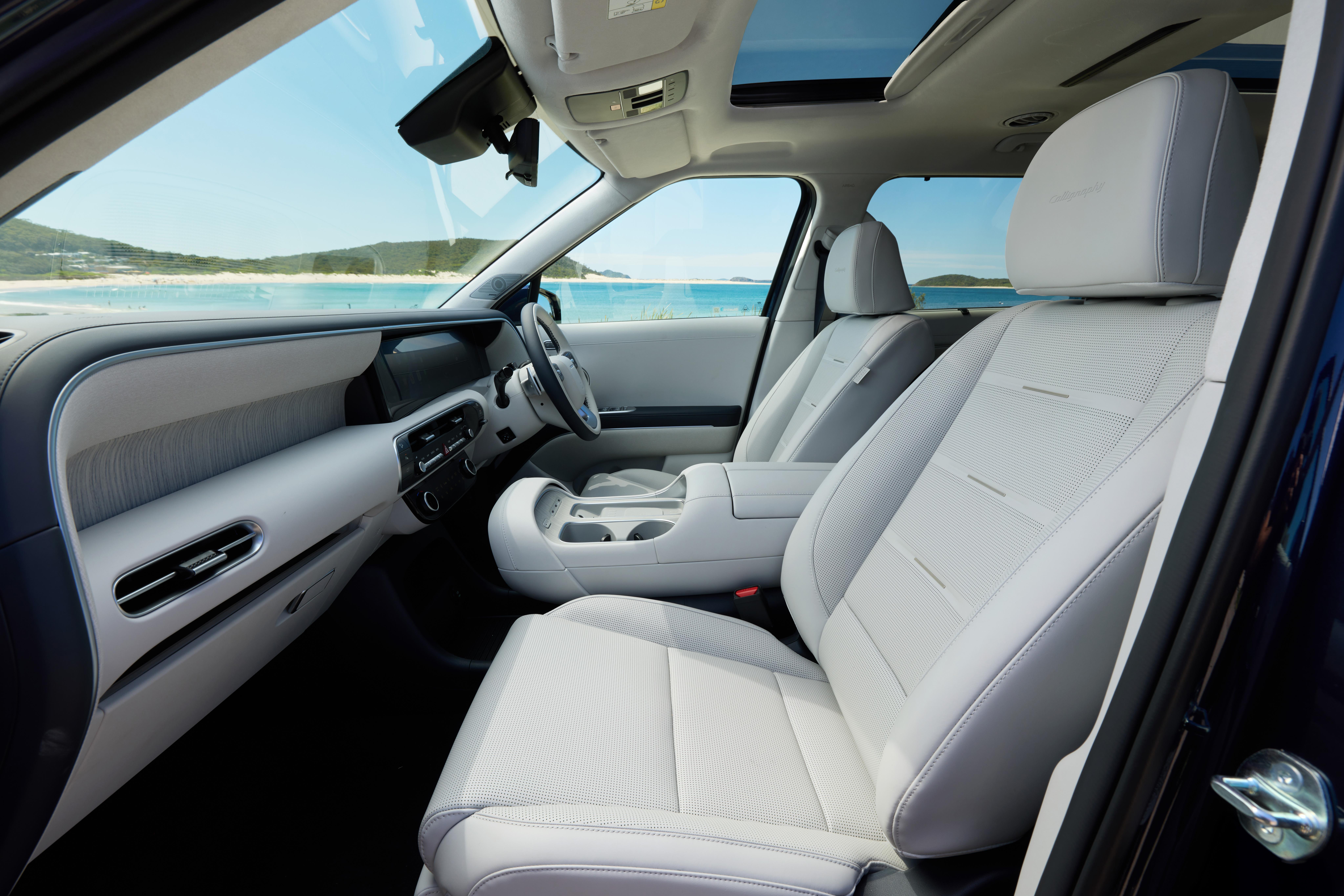
All Calligraphy models feature Nappa leather upholstery, with four different interior colourways available – brown, black, dark navy/light grey, and dark charcoal with brown stitching. I spent most of my time in a metallic blue example with the two-tone interior (as pictured) and while it’s my personal favourite from a purely aesthetic standpoint, I wouldn’t trust the average family to keep it clean.
The same can be said of the suede headliner, but that’s a risk I’d be willing to take.
Other interior panels are finished in a mix of leatherette, wood grain and hard plastic, although the latter has been kept to a minimum. In other words, material quality is strong across the board, although the dash and door cards could do with a little more padding.
The Mazda CX-90 feels similarly high-end in Azami trim, but the Palisade trumps its Toyota rival by a significant margin.
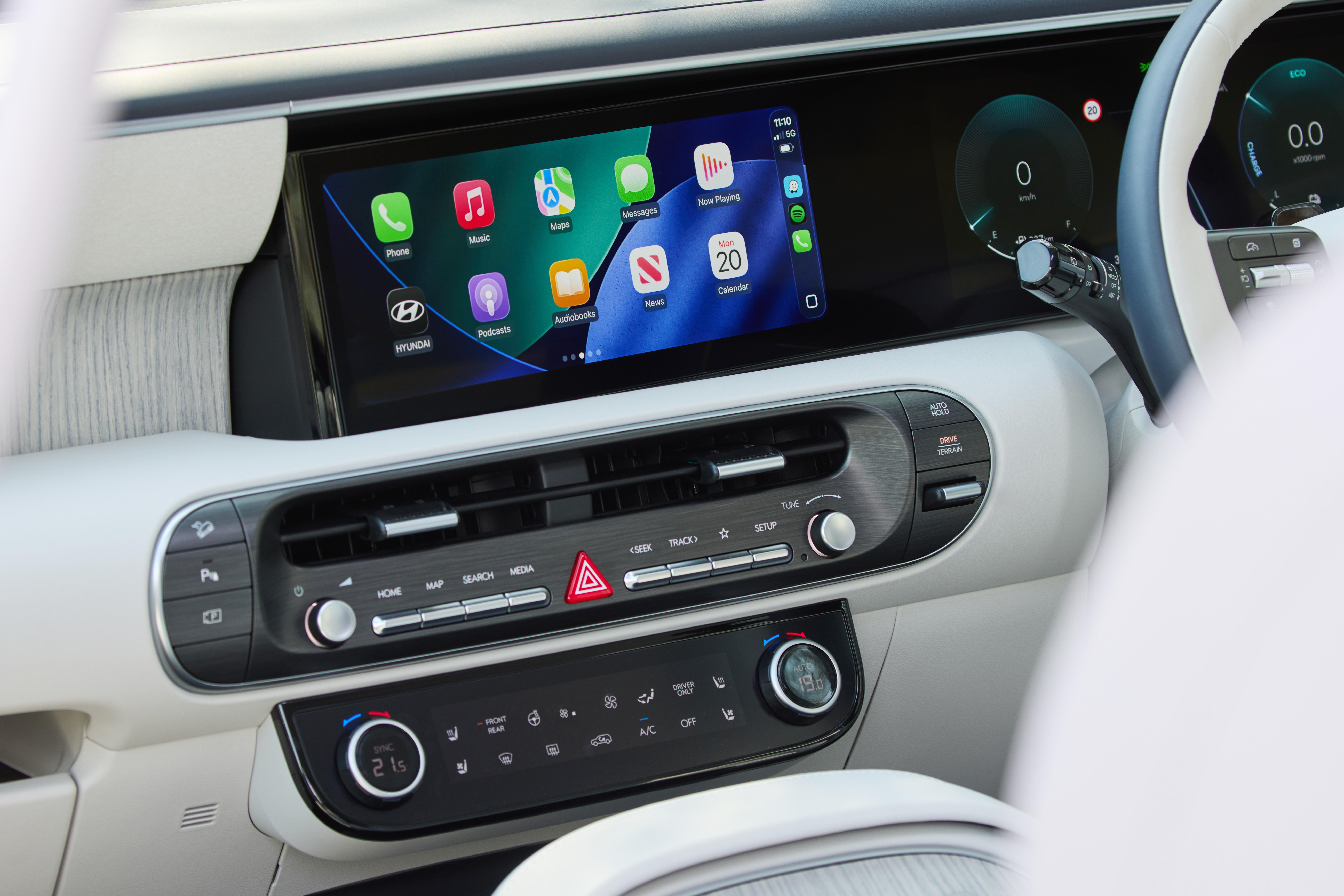

And one area in which the Palisade bests both its closest competitors is infotainment technology.
Neatly tucked into the dash is a single panoramic display housing twin 12.3-inch screens running Hyundai’s latest software, which means wireless smartphone integration, crisp graphics and a tile menu system that’s a breeze to navigate.
Even if you’re not sold on the whole touchscreen thing, Hyundai has retained a healthy amount of physical controls to make living with the Palisade that little bit easier. There’s a dedicated climate control panel with traditional rotary temperature dials, as well as an additional control panel above housing physical buttons linked to key infotainment menus. Everything is clearly labelled, except for an anonymous drive mode toggle that lives next to the steering wheel.
Moving across further, the digital driver’s display offers plenty of scope for customisation of both the data and visual themes, while more driving data can be found on the windscreen courtesy of a standard head-up display.
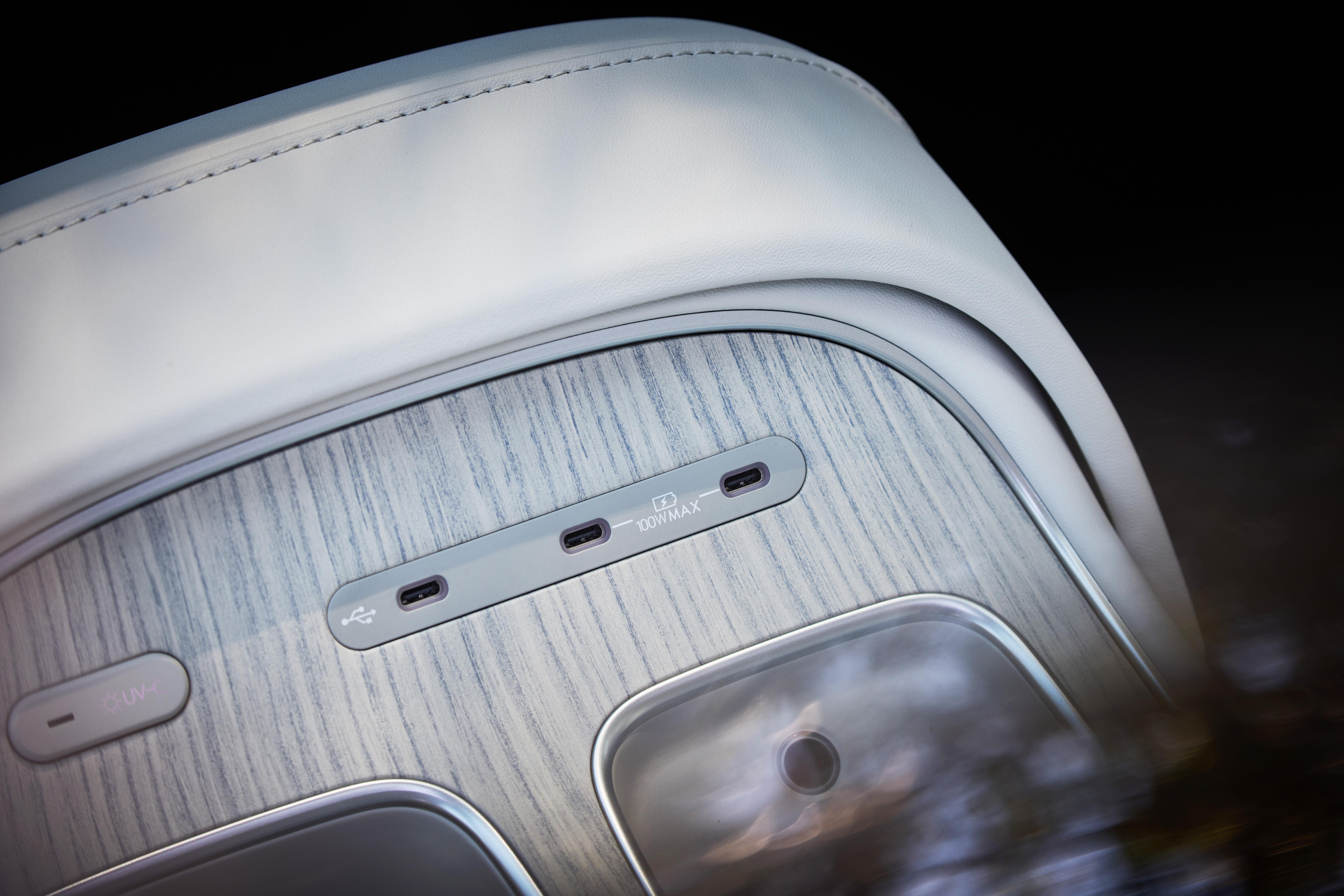

Connected services is standard, and you can lock and unlock the Palisade using a digital key on your smartphone.
Given the abundance of tech inside the Palisade, it’s no surprise that connectivity options are likewise in high supply. Three fast-charging USB-C outlets are located at the front of the floating centre console, which also houses a wireless charging pad.
Cabin storage is less abundant, however. The floating centre console opens up space at the base of the centre stack for a large storage tray, but the door bins won’t fit larger drink bottles and the glovebox is likewise tight. The centre console bin is also more shallow than it ought to be, although it scores a point for its clever UV-C sterilisation function – a modern way to keep your phone and keys clean.
At this point you might be questioning my claims about the Palisade’s practicality, but just hold off on that for a moment. Why? Because the passenger and luggage areas more than make up for some small-ish storage compartments.
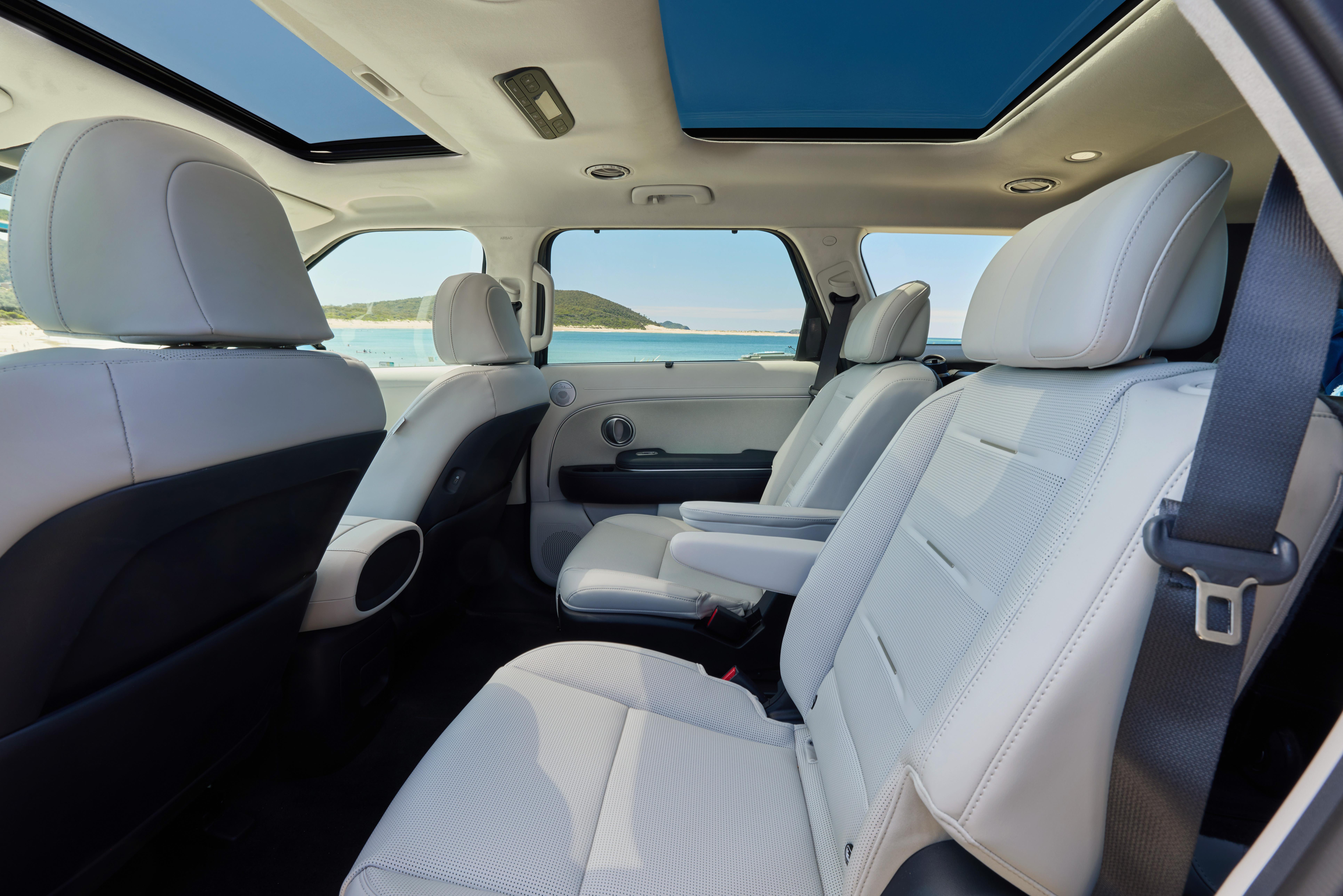
We tested the seven-seat model with second row captain’s chairs, and that’s the one to have if you want the kids to travel in style. In addition to full electric adjustment, these seats come equipped with heating and ventilation functions, as well as a dedicated armrest. Now that’s what I call fun for the whole family.
Big kids will fit back there without issue, and I consider myself a big kid at 185cm. There’s plenty of leg- and headroom, while the space is bathed in natural light courtesy of dual sunroof setup that allows rear passengers to play around with the roof without disrupting the ambience up front.
Amenities in the second row include manual window blinds, USB-C outlets and climate control, while storage is covered by a sliding drawer in the centre console, map pockets, and decent door bins.
Safety also gets a big tick, as side curtain airbags extend all the way back to third row and the rear doors contain safe-exit warning sensors.

So, it must suck to be forced to sit in the third row, right? Nope, not at all.
Most large SUVs are cramped in the ‘back-back’, but not this Palisade. The inclusion of power adjustment for the rear seats brings a whole new level of usability to the third row, and even these oft-neglected chairs are heated (outboard only). Occupants also have access to USB-C outlets, cupholders and dedicated air vents.
The generosity of the third row really helps to set the Palisade apart from smaller seven-seat SUVs, and makes it a great option for growing families.
Boot capacity is another strength of this newcomer. With 300 litres of space behind the third row, the Palisade shades the CX-90 (257L), Kluger (241L), and smaller Sorento (187L).
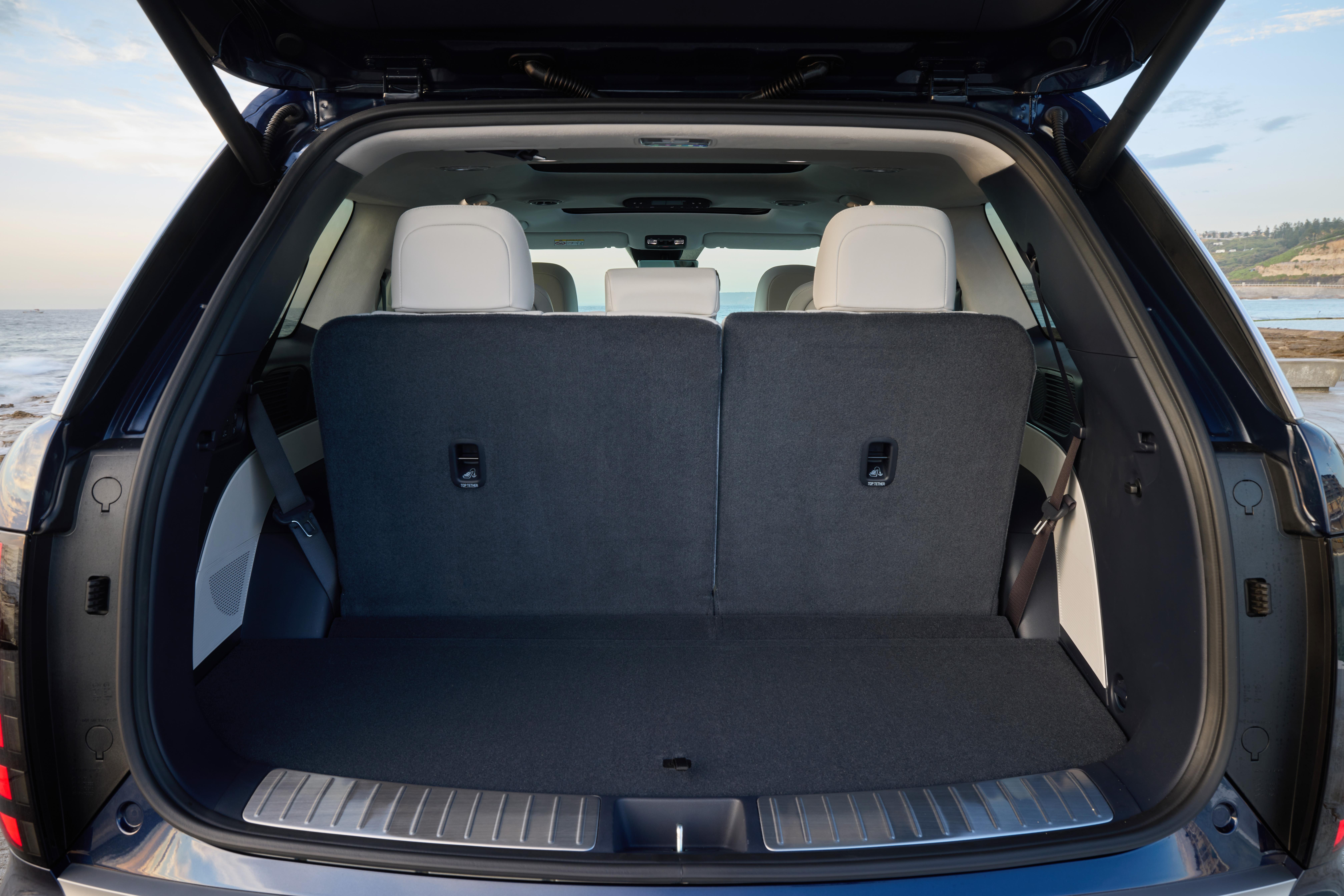
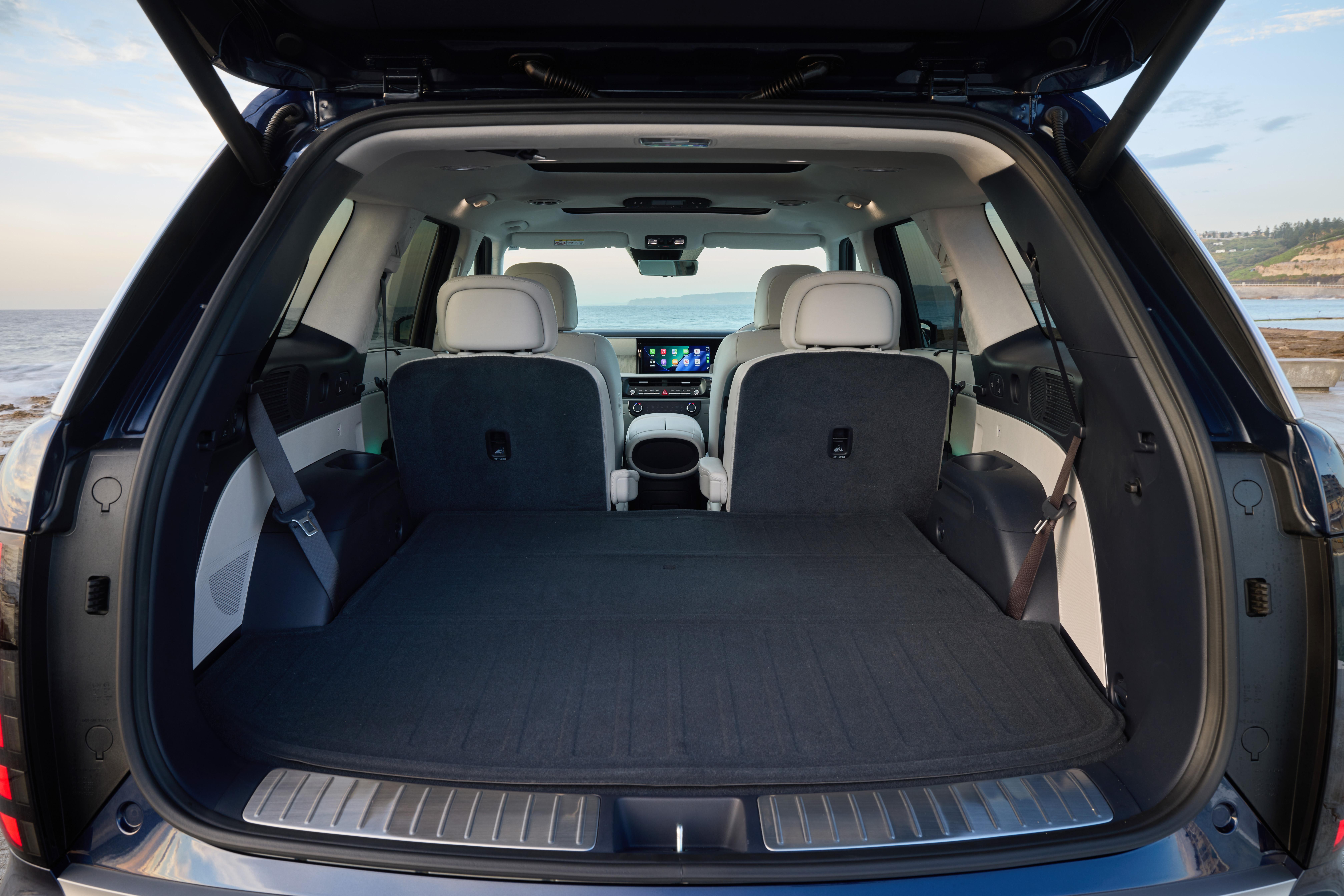
As an added bonus, you can create more room by taking full control of the seating configuration from the rear of the vehicle using buttons built into the boot wall to fold each of the second- and third-row seats.
Being a hybrid, the Palisade also has a vehicle-to-load power socket down back, as well as a regular 12V outlet. And better yet, there’s a full-size spare wheel mounted underneath the vehicle.
| Dimensions | Hyundai Palisade |
|---|---|
| Length | 5060mm |
| Width | 1980mm |
| Height | 1805mm |
| Wheelbase | 2970mm |
| Cargo capacity | 300L (behind third row) 712L (behind second row) 2081L (behind first row) |
To see how the Hyundai Palisade lines up against the competition, check out our comparison tool.
What’s under the bonnet?
Hyundai has ditched diesel power for the second-generation Palisade, replacing it with a new dual-motor hybrid powertrain that sends 245kW of power and 460Nm of torque to all four wheels through a six-speed automatic transmission.
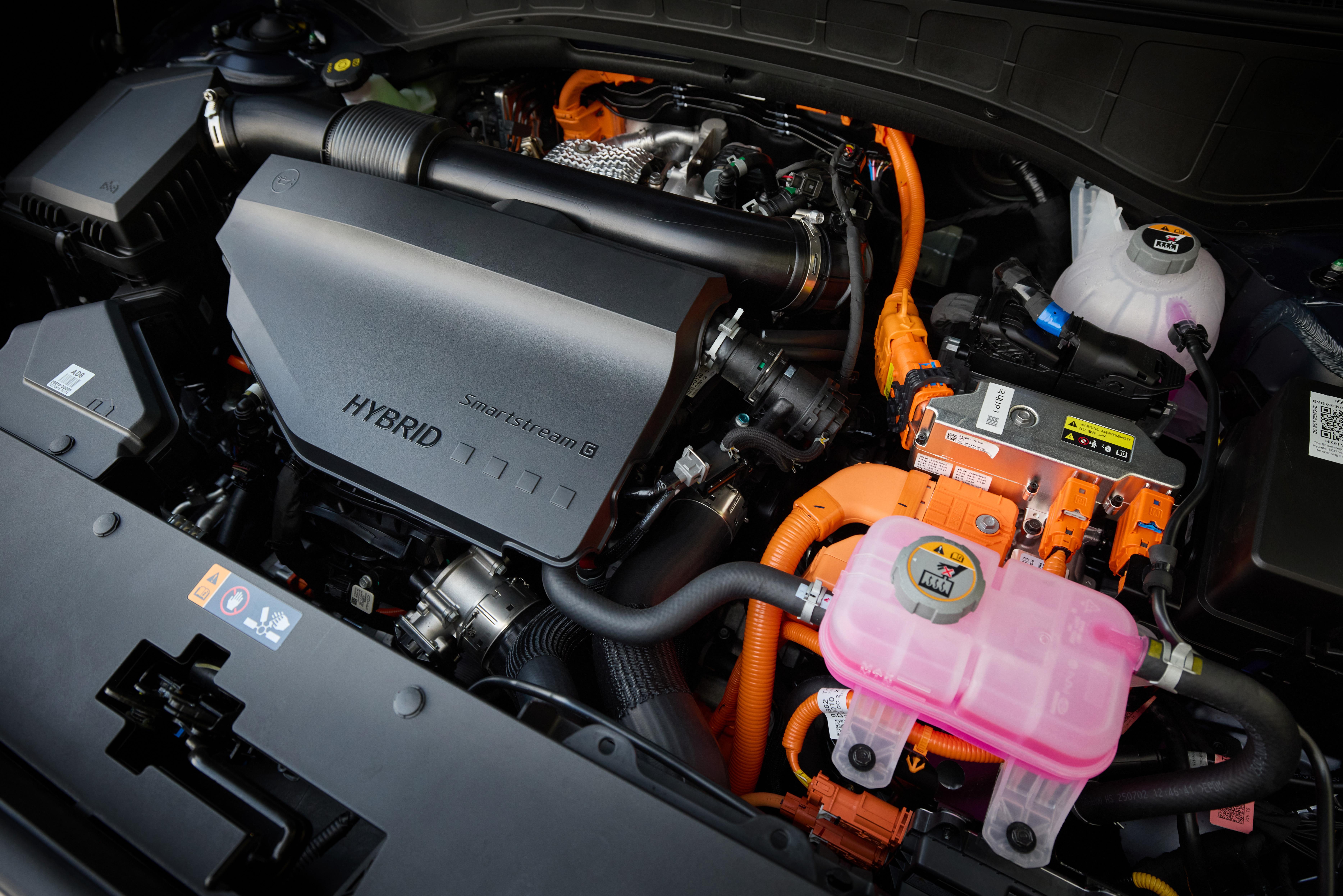
| Specifications | Hyundai Palisade Calligraphy Hybrid AWD |
|---|---|
| Engine | 2.5L 4cyl turbo-petrol hybrid |
| Engine outputs | 192kW 353Nm |
| Electric motor outputs | 54kW 264Nm |
| System outputs | 245kW 460Nm |
| Battery | 1.65kWh lithium-ion |
| Transmission | 6-speed automatic |
| Drive type | All-wheel drive |
| Weight | 2175-2294kg (7-seat) 2185-2304kg (8-seat) |
| 0-100km/h (claimed) | N/A |
| Fuel economy (claimed) | 6.8L/100km |
| Fuel economy (as tested) | 7.6L/100km |
| Fuel tank capacity | 72L |
| Fuel requirement | 91-octane regular unleaded |
| CO2 emissions | 145g/km |
| Emissions standard | Euro 5 |
| Braked tow capacity | 2000kg |
To see how the Hyundai Palisade lines up against the competition, check out our comparison tool.
How does the Hyundai Palisade drive?
In a world where SUVs are getting firmer and more sporty, Hyundai has instead opted to stick with a laissez-faire personality for the Palisade.

After all, this is a big family SUV, and there’s only so much you can do to disguise that. I emphasise the ‘big’ part, as the Palisade feels truly huge on the road.
On our way out of Sydney towards the Hunter Valley, I often found myself struggling to stay within the lane markings, such is the width of this vehicle. Parking and low-speed city manoeuvres can prove a bit of a hassle too, although light steering and the fitment of a high-resolution surround-view camera system makes placing the Palisade a slightly less daunting task.
That size is also evident in how the Palisade handles on open stretches of road. It demonstrates considerable body roll through sharper bends and understeers if you carry decent speed into a corner, so don’t expect delightful dynamics. Something tells me the average Palisade buyer isn’t partaking in too much spirited driving, though.
And, in this case, the payoff for average handling is superb ride comfort.
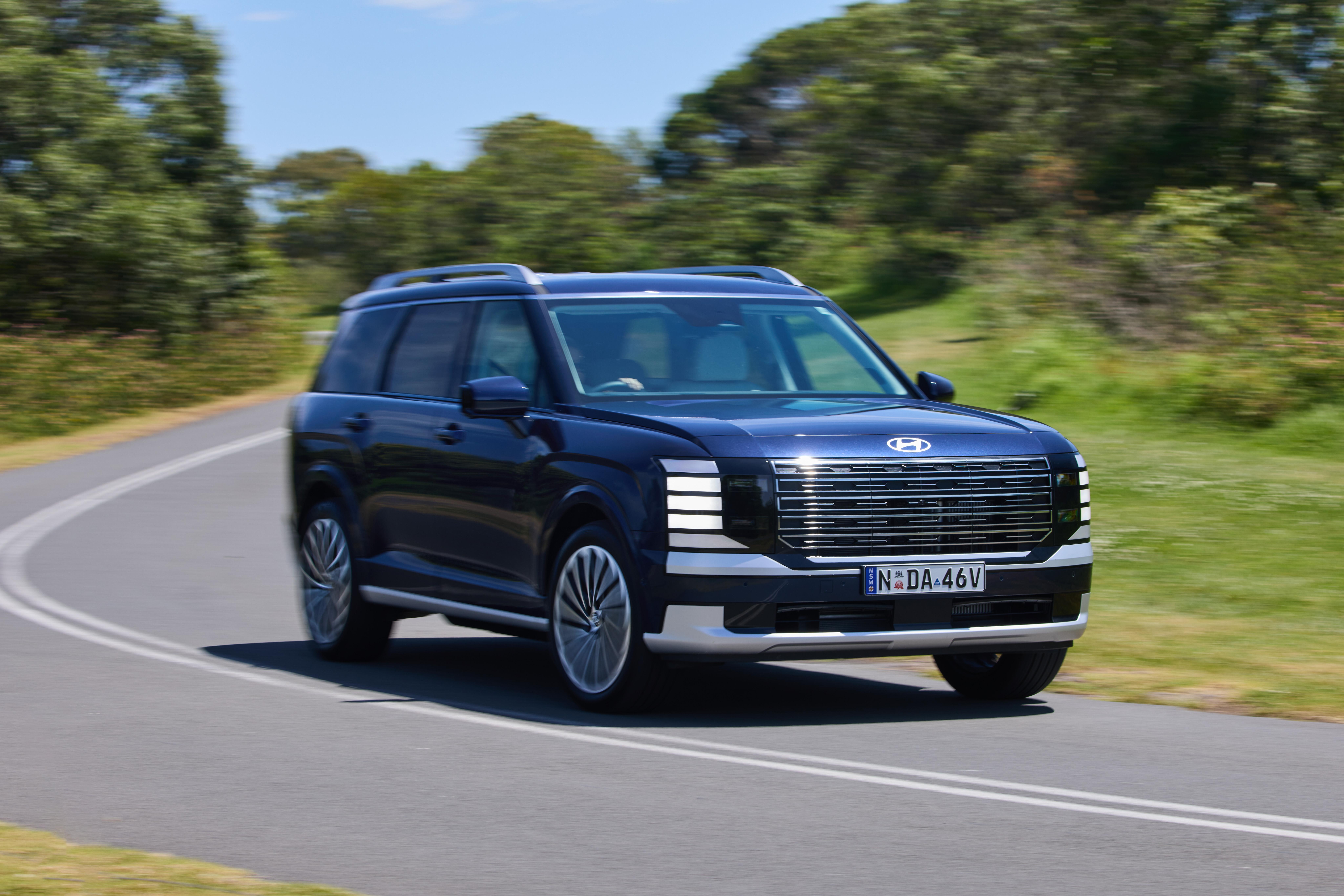
Hyundai’s suspension engineers went out of their way to tune the passive self-levelling dampers specifically for Australian conditions, a process that wasn’t undertaken during the development of the Ioniq 9 or Tucson.
So when we were dealt a drive route that included some pretty shoddy country roads, the Palisade handled the task with aplomb. You can feel the road surface through the chassis and seat, but the suspension does a fantastic job of taking the edge off harsh impacts. Deep potholes and ruts are managed exceptionally well; you know you’ve hit them, but there’s no loss of composure.
Indeed, compression and rebound is always controlled, and the Palisade never feels floaty or unsettled over longer undulations.
It’s this ‘just right’ balance that engineers strive for in a large SUV, and the engineers at Hyundai have done a great job.

Like footy and a meat pie, the Palisade’s impressive ride quality pairs perfectly with a high level of general refinement.
Even at highway speeds, the cabin is a quiet sanctuary free of annoying tyre roar or wind noise – both premium attributes. Insulated tyres help with this, as does the use of acoustic laminated glass for the windows.
The new hybrid powertrain deserves credit, too. It starts up in silence, and remains impressively quiet unless you really flex your right foot.
However, there’s work to be done on the power delivery front. The hybrid Palisade produces 245kW and 460Nm – right up there with the segment leaders – but the numbers only tell half the story.

That’s because the Palisade is frustratingly slow to respond to right pedal inputs. There’s almost always a moment of hesitation before bursts of acceleration, as if the throttle is asking “are you sure?” before sending its message onward. In a similar vein, the throttle also occasionally feels ‘stuck’ open even after you lift off, which erodes your confidence in the car further.
It’s not all doom and gloom, as once the Palisade gets going it delivers strong pulling power superior to its predecessor.
The new hybrid system utilises a dual-motor design, with one motor dedicated to generating power while the other drives the wheels. Hyundai says the next-gen tech extends EV driving range, saves fuel and enables uniquely electric functions including vehicle-to-load (V2L) and ‘Stay Mode’ – the ability to power vehicle electronics without running the engine.
We didn’t get the chance to test those latter functions, although we found evidence to suggest the second-generation Palisade is indeed more efficient than the last. Not quite as frugal as a Kluger, though, or PHEV alternatives.
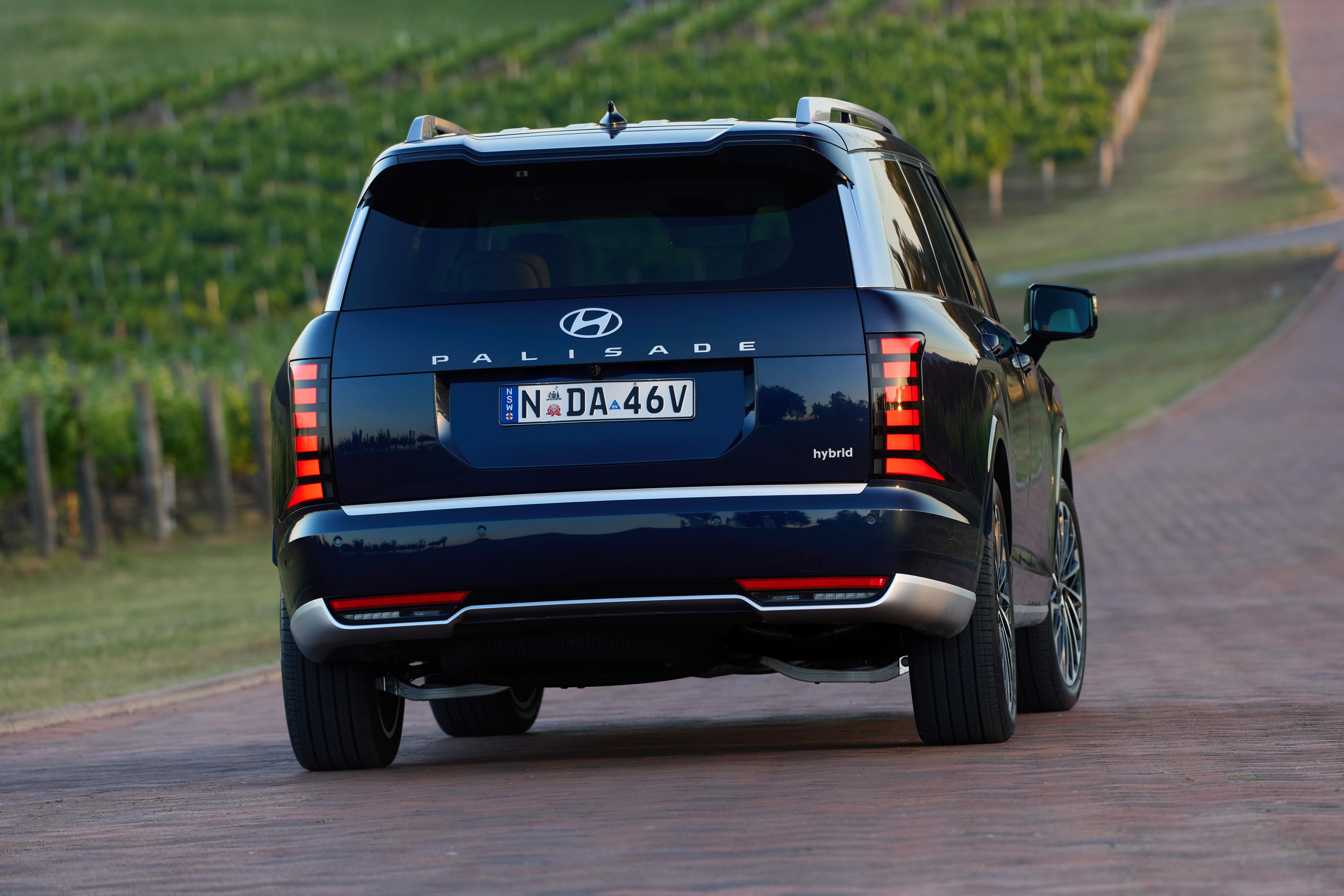
You can configure the driving experience using a small, unlabelled drive mode selector sticking out of the dash – toggling on the switch reveals eco, sport, and custom modes.
Hyundai says it has also updated its suite of advanced driver assist systems (ADAS) to make the safety systems more user-friendly. While they’re right in the sense that you can now permanently disable the speed limit changeover chime, there are still more than a few intrusive nannies that undermine the driving experience.
For example, the lane-keep warning system is overly sensitive considering the awkward dimensions of the Palisade. Thankfully, however, you can mute it by pressing a button on the steering wheel. You’ll also want to disable the overspeed warning system by holding down the volume control.
Overall, the Palisade’s safety systems feel a little too eager, especially for a model with premium aspirations.

In a slightly unusual turn of events, our test drive included an unexpectedly long stint on gravel roads. While the Palisade isn’t marketed as an off-roader per se, the presence of all-wheel drive and terrain-based drive modes suggest it has some level of capability off the blacktop, and my brief experience didn’t disprove this.
Nevertheless, adventurous types are better off buying a Ford Everest Tremor or a Toyota LandCruiser, at least until the beefed up Palisade XRT Pro arrives early-mid next year.
To see how the Hyundai Palisade lines up against the competition, check out our comparison tool.
What do you get?
The Palisade will only be available in flagship Calligraphy specification from launch, although Hyundai Australia will introduce lesser variants.
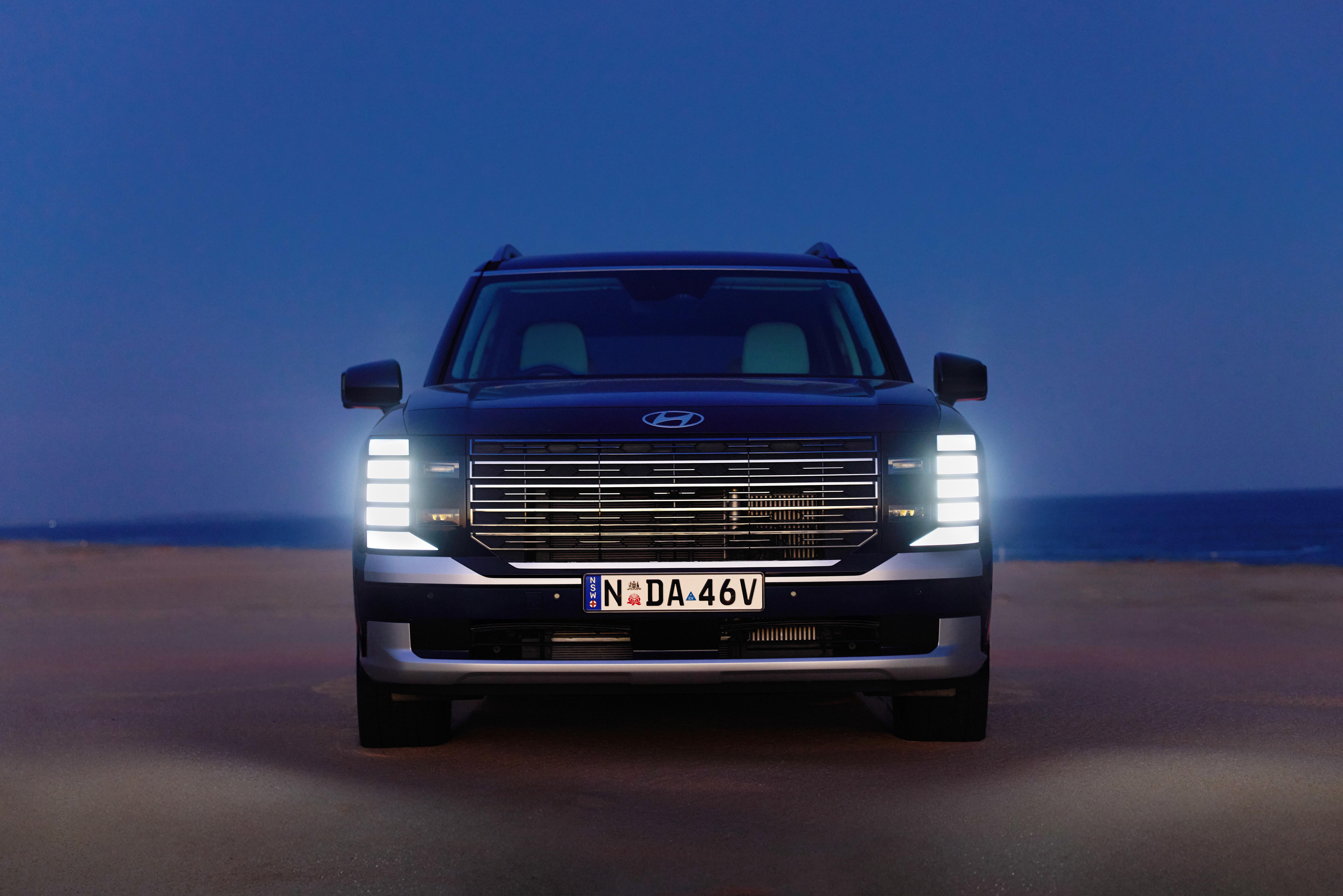



2026 Hyundai Palisade Calligraphy equipment highlights:
- 21-inch alloy wheels
- Dual tilt and sliding powered sunroof
- LED headlights
- LED tail-lights
- Privacy glass
- Roof rails
- 12.3-inch touchscreen infotainment system
- 12.3-inch digital instrument cluster
- 14-speaker Bose sound system
- Satellite navigation
- Nappa leather upholstery
- Suede headlining
- 16-way power-adjustable driver seat with memory
- 12-way power-adjustable passenger seat
- Heated and ventilated front seats
- Power-adjustable steering wheel with heating
- Second row relaxation seats (seven-seat option)
- Powered second- and third-row seats
- Heated and ventilated second-row outboard seats
- Heated third-row outboard seats
- 6 x 100W USB-C outlets
- Digital Key
- Fingerprint recognition
- Wireless phone charger
- Rain-sensing wipers
- Digital centre mirror
- Head-up display
- Full-size alloy spare wheel
- Bluelink connected services with OTA updates
To see how the Hyundai Palisade lines up against the competition, check out our comparison tool.
Is the Hyundai Palisade safe?
Hyundai Australia is targeting a five-star ANCAP rating for the new Palisade, after the previous-gen model launched with four stars.

Standard safety equipment includes:
- 8 airbags
- Front, side and rear parking sensors
- Blind-spot monitoring
- Parking collision avoidance
- Highway Driving Assist 2
- Forward collision avoidance
- Intelligent speed limit assist
- Lane-keep assist
- Surround-view cameras
- Smart Cruise Control 2 with stop/go
- Tyre pressure monitoring system
To see how the Hyundai Palisade lines up against the competition, check out our comparison tool.
How much does the Hyundai Palisade cost to run?
The new Palisade is covered by Hyundai Australia’s seven-year, unlimited-kilometre warranty.
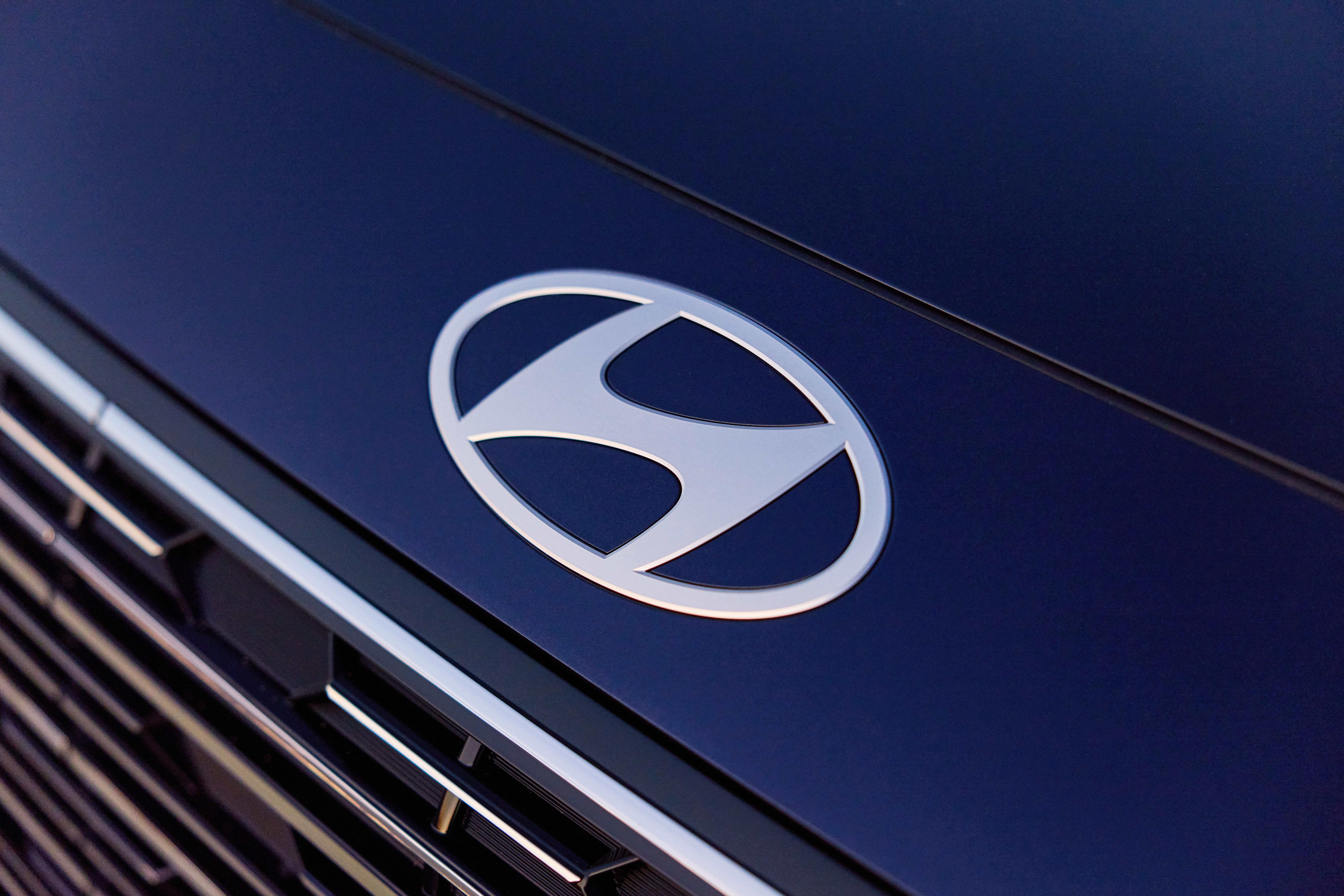
| Servicing and Warranty | Hyundai Palisade |
|---|---|
| Warranty | 7 years, unlimited kilometres |
| Roadside assistance | Lifetime |
| Service intervals | 12 months or 10,000km |
| Capped-price servicing | 5 years |
| Average annual service cost | $520 |
| Total capped-price service cost | $2600 |
Servicing is required every 12 months or 10,000km – a shorter interval than the previous-generation model, and indeed most rival seven-seat SUVs.
However, provided you don’t cross that 10,000km barrier, five years of capped-price servicing costs just $2600 at an average of $520 per year, which is less than you’ll pay to maintain an XC90, CX90 or Sorento PHEV over the same period.
To see how the Hyundai Palisade lines up against the competition, check out our comparison tool.
CarExpert’s Take on the Hyundai Palisade
I could only speculate after driving the prototype, but now I’m sure – the new Palisade is the best large SUV south of $100,000, and a true Korean Range Rover.

Revitalised as a hybrid, the second-generation model drives and rides like a proper luxury SUV. It’s soft and cushy over Australia’s coarse roads, yet not short of a gallop when you flex your right foot.
And regardless of your driving style, the hybrid Palisade is a relatively frugal beast despite its immense heft.
The redesigned interior equally deserves praise. Quite simply, the configurability of the seating arrangement is best in class – with all seven (or eight) seats in place the Palisade is a spacious family hauler, but at the push of a button it transforms into a luxurious van.
At least in top specification, the seats themselves are also hugely comfortable, especially the driver’s pew which benefits from all the usual premium features as well as power-adjustable side bolsters and an excellent massage function.
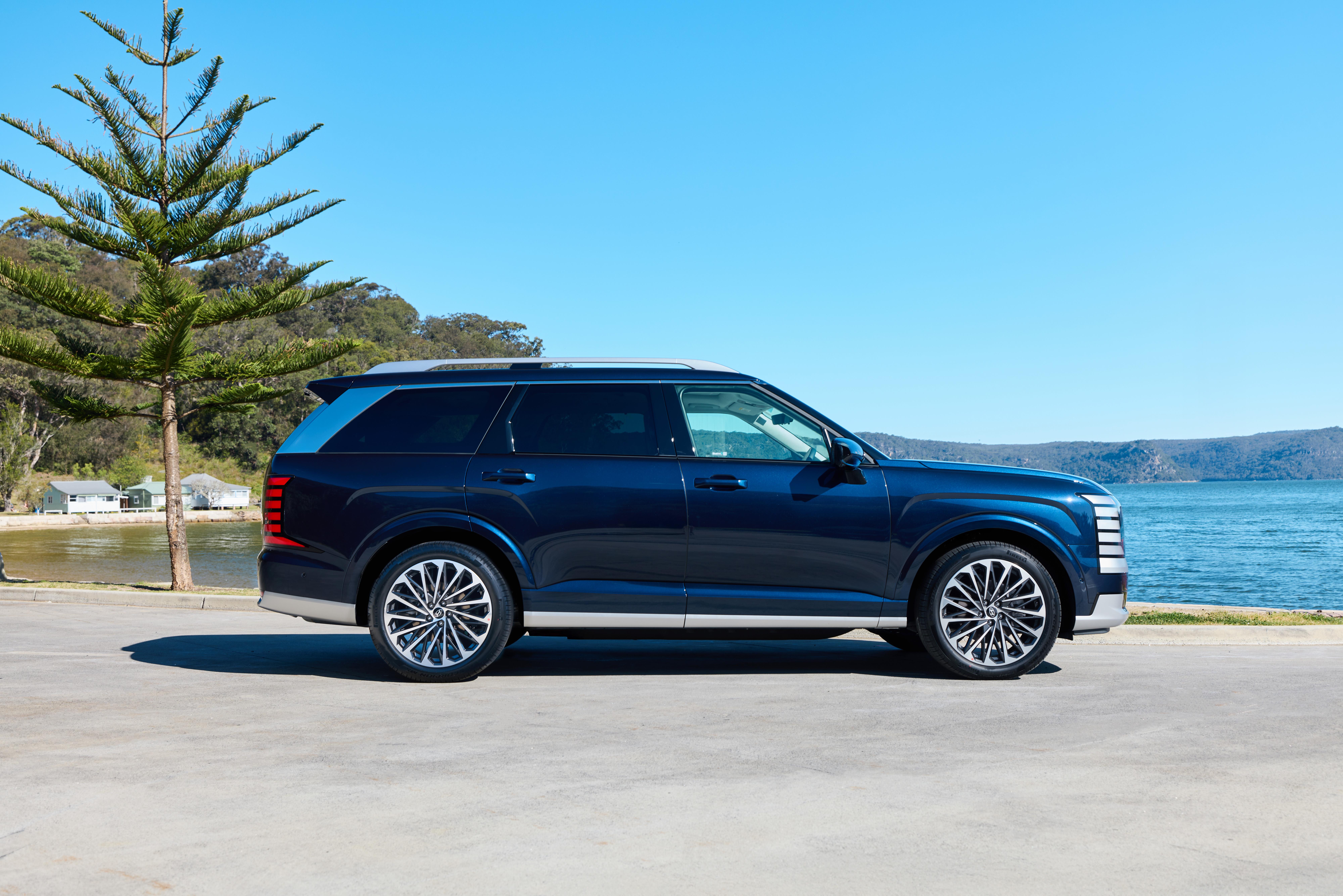
Being a brand-new model, the second-gen Palisade also scores the latest infotainment technology that Hyundai has to offer, all of which is user-friendly and pleasing on the eye.
So, why wouldn’t you buy a Palisade? Well, it doesn’t offer much from a driving engagement standpoint, but that’s unlikely to bother most large SUV buyers, although the disobedient throttle response may. Some of the safety features are quite annoying too, and I suppose the 10,000km service intervals will bug some potential buyers.
But I’m hard pressed to come up with compelling reasons to buy a top-spec Kluger or CX-90 instead. Neither can claim to offer the same level of space, technology and luxury as the Palisade – a vehicle that’s only slightly more expensive.
Even the financial argument is undone by the fact that Hyundai is set to launch more affordable versions of the Palisade next year. As such, those in the market for a big barge that can do it all would be wise to stick the Palisade at the top of their shortlist.
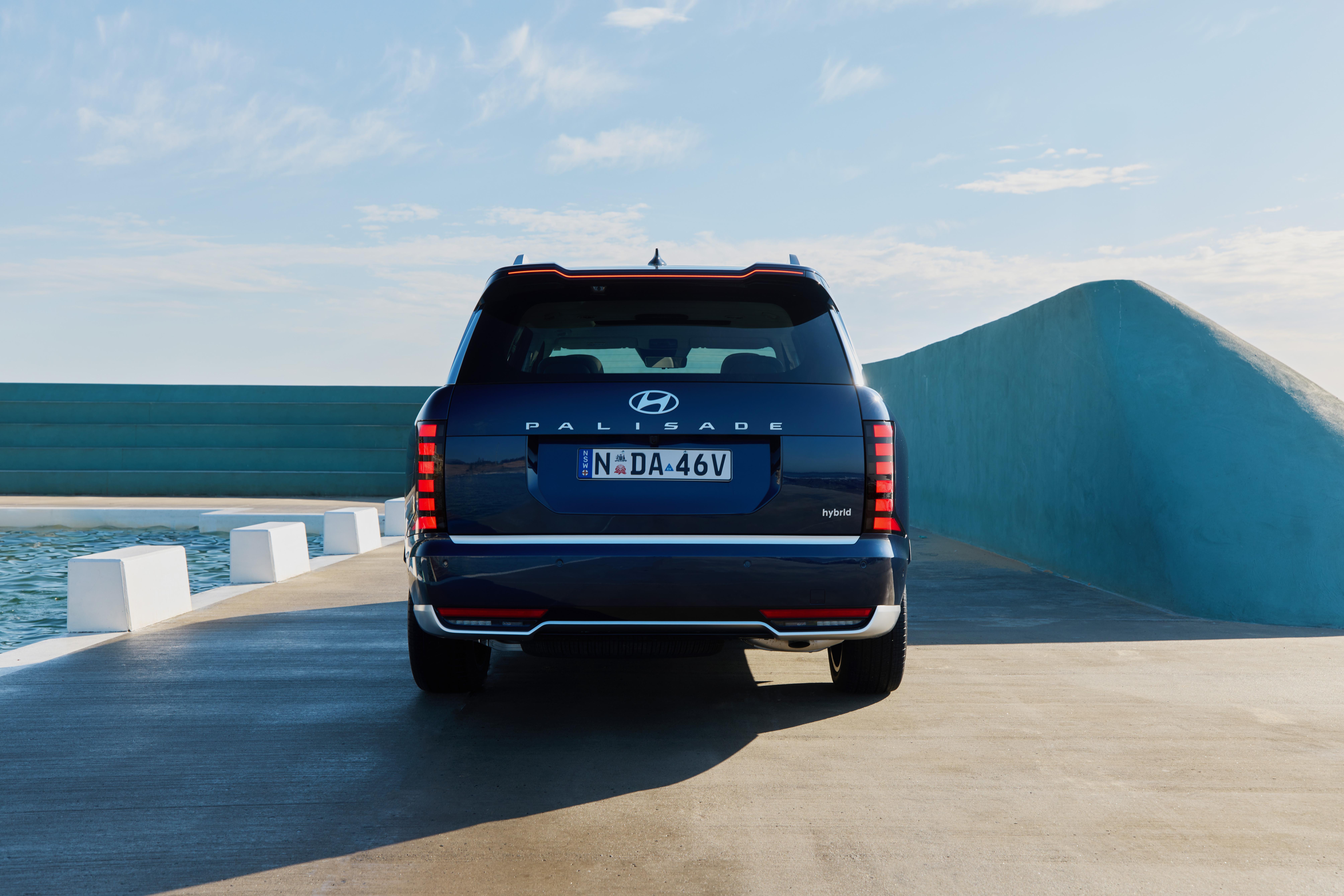
CarExpert can save you thousands on a new Hyundai Palisade. Click here to get a great deal
Click the images for the full gallery

